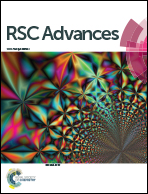Improved electron extraction by a ZnO nanoparticle interlayer for solution-processed polymer solar cells†
Abstract
Charge injection/extraction properties dictate the device characteristics of polymer solar cells. Based on a model system comprising PTB7-Th:PC71BM blends, we investigate solvent effects and interface properties of ZnO nanoparticles used as electron-transporting/hole blocking interlayers (ETL/HBL) to improve the solar cell performance and stability. We find that the polarity of processing solvents and thickness of ZnO nanoparticles ETL both play a crucial role in the device behavior. Under the optimal conditions, the power conversion efficiency (PCE) is increased from 8.4% to 9.2% for PTB7-Th:PC71BM solar cells with a conventional device architecture, which is among the highest efficiencies for this blend system. The simultaneous increase in short-circuit current (Jsc) and fill factor (FF) originates from an effective hole blocking mechanism provided by the ZnO layers which increase the selectivity of charge extraction and reduce non-geminate charge recombination. The dense and air-stable ZnO ETLs minimize the diffusion of moisture and O2 into the photoactive layer, leading to drastically improved device stability.



 Please wait while we load your content...
Please wait while we load your content...